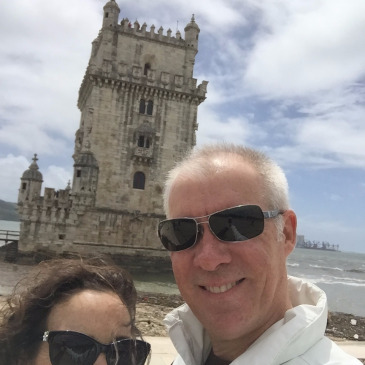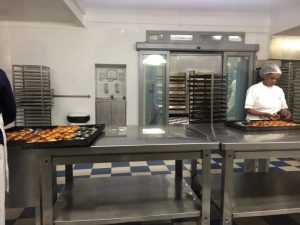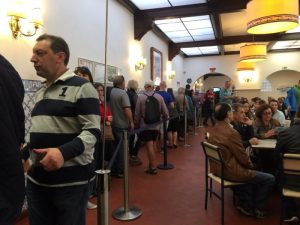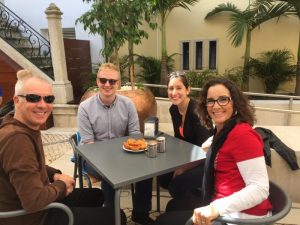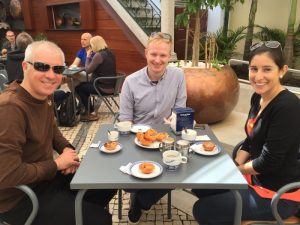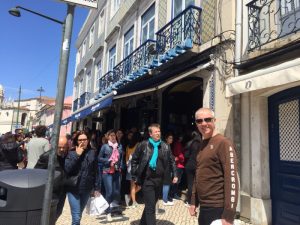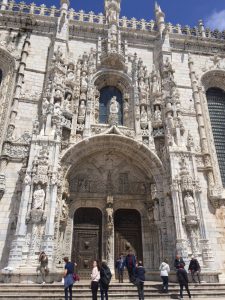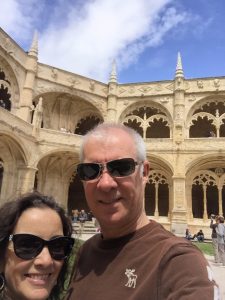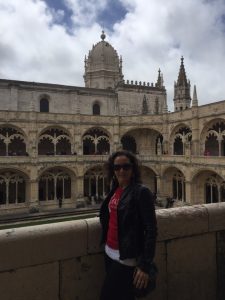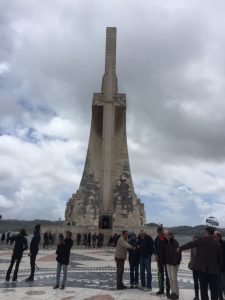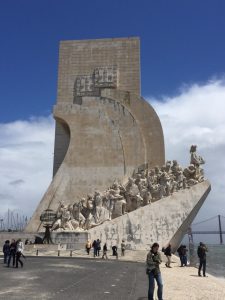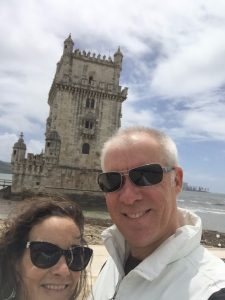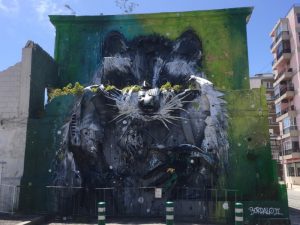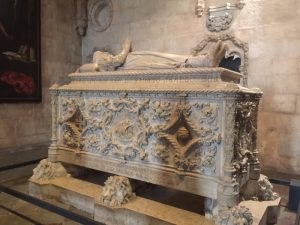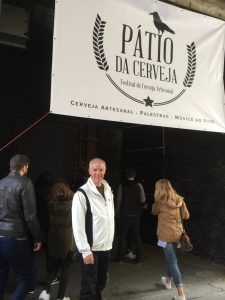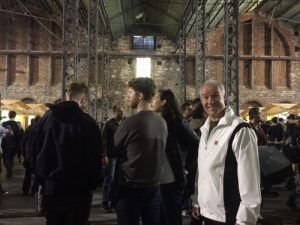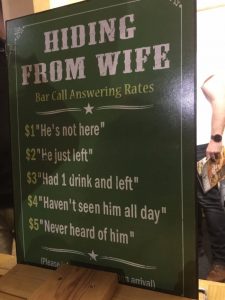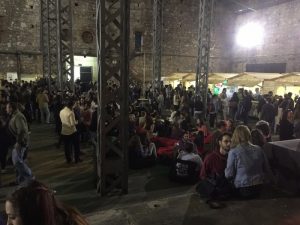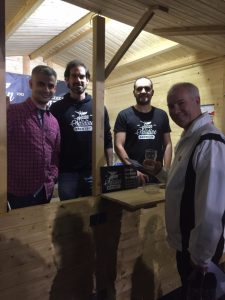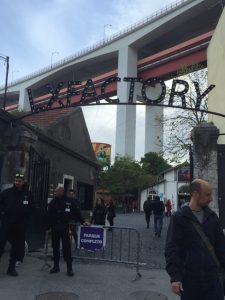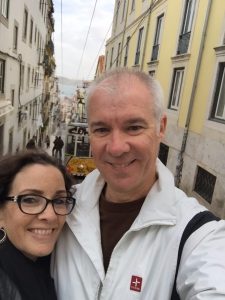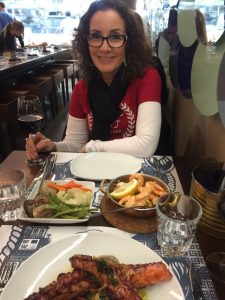Sunday 8th May: Belem Tour Day.
Mark and I woke to a fairly clear sky, and even the odd bit of sunshine, and so we headed out for a walk along the Harbour before meeting up at 10 am with our walking group tour to Belem.
There were 10 people in our group and four of them had been in our Alfama tour so it was nice to see some familiar faces. They were two delightful and chatty Peruvian twin girls and their partners, another Peruvian guy and a Dane. Our guide for the Belem tour was Yuri and he started by advising us that any tour of Belem is greatly tied up with an understanding of the Discovery Age and, so, the history lessons continued. The Discovery Age refers to that period in history, predominantly the 15 & 16 Century for Portugal, when Europeans embarked on overseas exploration thereby expanding their territories and knowledge of the wider world. The motivation for this period was to develop alternative trade routes to places such as India and thereby compete with the great trading route known as the Silk Route. The Silk Route finished up in Venice and lots of extra costs had to be added on to goods to eventually get them down through Spain and on to Portugal. This extra cost was crippling the Portuguese economy, hence the need for an alternative trade route for the country.
With that bit of historical context, we started the tour proper once making the 10 min train trip from Lisbon west, along the coastline, to Belem.
Belem is an area that is now filled in with land but it used to be a beach where wealthy families would gather and it was from this beach area where the great Portuguese ships of discovery were ultimately launched.
One of the most imposing structures in Belem is the Monastery of Saint Jeronimos. This is now a World Heritage site and was commissioned to be built by King Manuel in 1495 as he wanted a place to be available for spiritual guidance of the sailors who were embarking on their voyages of discovery. One interesting fact about this Monastery was that it was paid for by charging 5% tax on the spice, pepper. This was not our first stop on the tour but it is tied up with history of what was to be our first stop.
Our first stop was at the famous pastry shop of Pasteis de Belem where, on any weekend, they can bake up to 50,000 of their famous custard tarts per day. The origin of these tarts is tied up with history of the Monastery in that the expulsion of the Religious orders from convents and monasteries during the 1820s meant that the Religious needed to find an alternative sources of income and, so, the Monks of St Jeronimos started selling small pastries called, Pasteis de Nata meaning ‘pastries of cream’. The Monastery subsequently closed but the recipe was sold on to Pasteis de Belem and, much like that of the recipe for Coca-Cola, only three people are entrusted with the full knowledge of the recipe and they not allowed to fly together so as to ensure the safety and longevity of this successful recipe and business.
We then moved on to visit the famous Monastery of St Jeronimos but it was so crowded that we only visited the Cloister section before heading over to the Discovery Monument. The Discovery Monument was built to pay homage to the many Portuguese who featured during the great Discovery Period. The Father of this great Discovery Age was Prince Henry the Navigator, who was actually not a navigator at all but was successful in mapping the night sky and fostering the discovery of the triangular sail that enabled easier sailing under any wind conditions. All of this helped the Portuguese on their great sea voyage expeditions to discover the West Coast of Africa and an alternate route to India around the bottom of Africa’s Cape of Good Hope. This started a golden age for Portugal as they now controlled an alternate, cheaper and faster route to the spices of India and it is Henry the Navigator who takes pride of place on the Discovery Monument.
From the Discovery Monument we walked along the waterfront to Belem Tower which is another World Heritage site. Belem Tower was used from 1515 to 1580 as a defense fortress but from 1580 this was used as a prison.
All of this history about the amazing feats of engineering and science and successful sea voyages during this Discovery Period begged the question, for me at least, what triggered the demise of the Portuguese from this great position in world history? Our guide then traced a series of events that is the main line of thought to explain this collapse. Yuri said that the initial trigger was the expulsion of the Jews from Portugal in 1496. King Manuel made a decree, so as to seal his marriage with Princess Isabella, that all Jews and Muslims must convert to Christianity or leave the city and, leave they did. The Jews went over to Holland and England and took with them all the knowledge of cartography, mathematics, and other navigation skills. It is no wonder that these two countries then went on to become the new world powers. Portugal went on to lose a lot of their kingdom after this period and this was then followed by the great earthquake of 1775, then Napoleon invaded in 1807 and then there were problems with their monarchy. The most recent period contributing to this demise came during the reign of the fascist dictator, Salazar, and his name kept popping up through our various tours. Much was made of the of the fact he claimed that the Portuguese people did not need to look outward or worry about education but really only the 3 Fs: That being Fatima (ie Religion), Fado (traditional music) and Football. Yep, you read correctly, through Soccer he thought the masses of people could be focused and controlled and this was his attempt to unite Portugal into a single, homogeneous group. However, all this really achieved over the long term was great political unrest and literacy levels that plummeted to less than 50%. The amazing thing to remember here is that this dictatorship only finished as recently as 1974!
With this rather sobering revelation our tour concluded, we then made our farewells and Mark and I wandered back to the Monastery along with our guide, Yuri, and one other member of the group, Eman Eldeeb. The four of us went back to the Monastery of St Jeronimos which was much less crowded by this stage and we finally saw the tomb of Vasco da Gama which was quite a buzz. Our guide left us then to head back to Lisbon but Eman joined Mark and I for lunch. Eman is a lovely young Egyptian girl who is also on holidays for a month and, like us, headed to Seville after Lisbon.
Mark and I left Eman after lunch to take the one-stop train journey to LX Factory. This is an area of old and disused warehouses that have been converted into a funky art, design and retail space. Well, that’s how it was described to us!
We eventually found the LX Factory with the help of Mr Google Maps and some kind local Lisboans. Mark was in 7th heaven after our arrival though as I soon found out that there was a special craft beer festival on today. It seems the Gods were looking over us today granting us sunshine and beer! We wandered through the LX Factory space in search of the said beer hall festival and thought that much of the area had a pretty similar vibe to that of Bondi Markets. There were lots of little shops selling new and used clothes, retro furniture and….junk! The beer hall exhibit though was pretty amazing. It was packed with heaps of mostly young and fashionably dressed Gen X and Ys, with a few Hipsters thrown in too, and all with a glass in their hand enjoying one of the vast array of beers on offer. Apparently, there were more than 28 different beer sheds with a total of 80 beers on offer. Mark made a new beer friend in the queue for more beer coins, a guy from New York, who said he was going to try all 80 of the beers and we think he must have been well on the way though as he thought I was a ‘girl’ and was surprised that I was Mark’s wife and he was even more surprised to learn that this LX Factory visit had been my idea!
Mark enjoyed about 6 beers before we finally left to make our way towards our final dinner destination of ‘Sea Me’ which was a great contemporary seafood restaurant.
BTW 1: Another key fact gleaned during the day was that there is a school of thought that Christopher Columbus was actually Portuguese and not Genovese. The belief is that he took on the Genovese disguise to hide the fact he was Portuguese, so the Spanish would fund his voyages of discovery. It is purported that he was born in an area of Portugal called Cuba and that his naming of the new land of Cuba, in Central America, was a homage to this very fact. Our Portuguese guide firmly believes this theory and, as a consequence, that the Portuguese discovered the WHOLE world! You can make your own mind up though.
BTW 2: Did you know that the Portuguese gave the word thank you to the Japanese? Obrigada in Portuguese. Origato in Japanese. Before the Portuguese “discovered” Japan the Japanese did not have a word for thank you – they just bowed.
